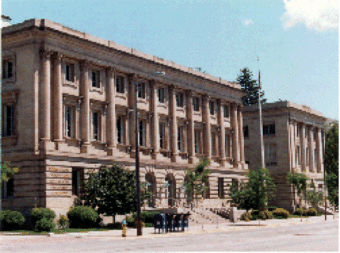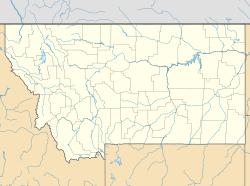United States Post Office (Missoula, Montana) facts for kids
Quick facts for kids |
|
|
U.S. Post Office
|
|

Federal Building, U.S. Post Office and Courthouse, June 2003
|
|
| Location | 200 E. Broadway St., Missoula, Montana |
|---|---|
| Area | 1.5 acres (0.61 ha) |
| Built | 1913 |
| Architect | Taylor, James Knox; Wetmore, James |
| Architectural style | Italian Renaissance Revival |
| NRHP reference No. | 79001406 |
| Added to NRHP | November 30, 1979 |
The Federal Building, U.S. Post Office and Courthouse in Missoula, Montana, is a historic building. It holds offices for different parts of the United States government. This building was constructed between 1911 and 1913. Later, it was expanded to include a courthouse for the United States District Court for the District of Montana. The building was expanded again in the 1930s. In 1979, it was added to the National Register of Historic Places, which lists important historical sites.
Contents
History of the Missoula Federal Building
Missoula started as a small village in the 1860s. It grew very quickly when the Northern Pacific Railroad arrived in the 1880s. By the early 1900s, Missoula became an important trading center. It served western Montana, northern Idaho, and eastern Washington.
Why Missoula Needed a Federal Building
Because Missoula's population was growing, more government services were needed. So, Missoula was chosen for a new federal building. In 1907, the government bought four lots for $19,850. These lots were on Cedar Street, which is now Broadway Street.
James Knox Taylor, the main architect for the U.S. Treasury, designed the building. Construction began in January 1911. The building officially opened in 1913. The first groups to use it were the U.S. Postal Service and the United States Forest Service. The local newspaper, The Daily Missoulan, called it "a handsome structure, an ornament to the city."
Building Expansions and New Uses
As Missoula kept growing, more space was needed for federal offices. In 1927, James A. Wetmore, another architect for the U.S. Treasury, designed an addition. This new part would house court functions. The expansion was finished in 1929. The building held its first U.S. District Court session on December 5, 1929.
Even with this new space, the building needed more room in the 1930s. Louis A. Simon of the U.S. Treasury Department designed a second addition. This part was officially opened on October 13, 1937.
Forest Service and Historic Events
Since 1914, the building has been the main office for the Northern Region of the U.S. Forest Service. In 1949, this building was where an investigation took place. It was about the tragic 1949 fire at Mann Gulch in the Helena National Forest. The 1952 movie Red Skies of Montana was based on this fire. A scene in the movie even shows the Federal Building.
Most postal services moved out of the building in 1974. However, a small post office still remains there. Many different federal agencies use the building today. The building was added to the National Register of Historic Places in 1979. The district court now meets in the Russell Smith Courthouse, which is across the street.
Building Design and Style
The Federal Building, U.S. Post Office and Courthouse is located on a block near the main business area. The original architect, James Knox Taylor, designed it in the Italian Renaissance Revival style. This style was often used for federal buildings across the country. Its classic design showed the importance of the federal government.
Exterior Features
The building has three stories. It is built with a steel frame and reinforced concrete. Even with the additions, the building looks like one complete structure. This is because the new parts were designed to match the original building. The bottom of the building is covered in smooth granite. The front and side walls are covered with limestone. The back of the building uses buff-colored brick, which was less expensive.
The building shows many features of the Italian Renaissance Revival style. The first floor has deep lines in the limestone. The front of the building is balanced, with arched entrances. The second and third floors have large limestone frames around the windows. These are also common features of the style. The upper stories have tall, attached columns called pilasters. These pilasters have fancy tops called Corinthian capitals, decorated with leaf patterns. An eagle carving on the 1929 addition shows the building's federal importance.
Interior Spaces and Details
The original building is connected to the 1929 addition by a narrow hallway. This hallway has a glass roof, making it an atrium. The U.S. Forest Service once used this area as a greenhouse. A small, one-story addition was added in 1952. It holds conference rooms and was the last part added to the building.
The post office lobby, part of the original building, still has many of its historic features. The floors are made of gray terrazzo with a gray marble border. This marble also goes up the wall, forming a lower section called wainscot. Above the wainscot, the walls are plastered and have pilasters, just like those outside. A decorative row of rectangular blocks, called a dentil course, goes around the lobby. The ceiling has painted plaster panels divided by beams. Original bronze lights hang from the ceiling and are also on the walls. The original oak doors are still there.
The lobby of the 1937 addition also keeps many original features. The floor has light and dark marble panels. These panels are set at an angle to the walls. The walls are covered with light beige marble. Each wall has an arched opening in the middle. The walls have dark gray marble at the bottom. A wooden trim with a dentil course tops the space. The plaster ceiling has a decorative circle from which a bronze light hangs down.
The arched opening on the west side leads to an exit. It has dark wood framing and a fanlight window above it. Decorative bronze circles are on either side of the exit. To the east, an arched opening leads to an elevator. This elevator has its original bronze doors and frames.
The courtroom is no longer used for court cases. However, some original features remain, even though it is now office space. The original wood and leather doors are still in place. Wooden panels cover the lower part of the walls. A painted wooden trim goes around the top of the room. Three tall, arched windows are on the north wall of the courtroom. The wooden frames and dividers around these windows are original.
Key Dates for the Building
- 1911–1913: The first part of the building was constructed.
- 1929: The first addition was completed.
- 1937: The second addition was completed.
- 1949: The building was used for the Mann Gulch fire investigation.
- 1974: Most postal services moved out of the building.
- 1979: The building was listed in the National Register of Historic Places.
Quick Facts About the Building
- Location: 200 East Broadway Street
- Architects: James Knox Taylor; James A. Wetmore; Louis A. Simon
- Construction Dates: 1911–1913; 1927–1929; 1937
- Architectural Style: Italian Renaissance Revival
- Landmark Status: Listed in the National Register of Historic Places
- Main Materials: Granite and Limestone
- Special Features: Classical details; Historic Postal lobby



